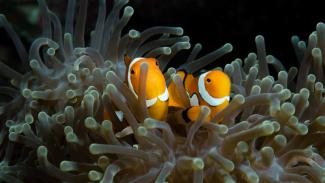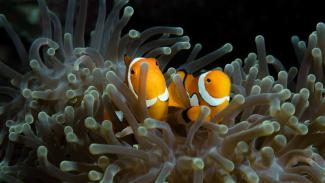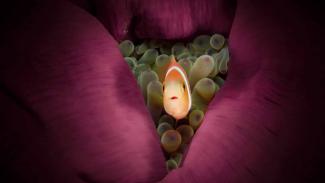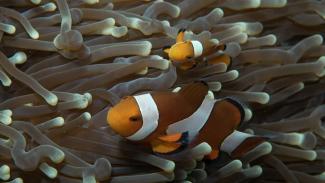Clownfish are great subjects for underwater photographers.
Not only are they colourful and full of character, but they are also one of the most iconic and well recognised fish in the sea. A good Clownfish photo nevers fails to provoke a reaction from your audience.
They are also a very tricky subject to photograph, leaving many budding photographers frustrated.
So what can you do to get a great shot?
Here's how....

Did You Know?
Freezing the action
The first problem with Clownfish is their speed of movement. They are quick and skittish, rarely staying still long enough to compose a good shot.
They are also very territorial, frequently darting aggressively towards your lens. We have all had frustrating experiences where every shot is blurred, or the Clownfish is only partly in the frame.
To overcome this, you need to freeze the movement so that it is sharp. If you have a simple compact camera with no manual controls, then the best way to do this is to select your camera's sport scene mode.
Sport mode is designed to capture fast action, so it is perfect for capturing your clownfish as he zips around his anemone. The mode works by selecting a fast shutter speed – the amount of time that the camera's shutter is open – preventing blurry movement.
If you camera has more controls, then you can try taking the shot in 'Shutter Priority' or 'Manual' mode – usually represented by 'Tv' and 'M' on your mode dial – and selecting a shutter speed of at least 1/500th of a second.
Colour & composition
The downside of using a fast shutter speed is that you will have less light in your shot. To overcome this problem, make sure you get as close as you can to your subject - without touching the reef of course.
The closer you are, the less distance the available light has to travel and the more colours you will have in your photo.
Getting close will also mean that the Clownfish, although very small, takes up a good proportion of your frame & does not just appear as a small orange dot in the background.
Another little trick is to pay attention to the host anemone. In a large anemone, the Clownfish can cover lots of ground, limiting your chances of getting a good shot. In a small anemone, his movements will be limited, giving you a better chance of success.
The final piece of the jigsaw is to watch the Clownfish patiently. Understanding fish behaviour is crucial to good underwater photography, so if you follow its movements for a couple of minutes, you may start to see a rhythm where before you saw only frantic, random movements. You can then use this to your advantage to capture a sharp, well-composed and well-lit shot of a Clownfish.
You may not get it right first time, but with a little bit of patience & a few attempts, you should have a shot to remember.




